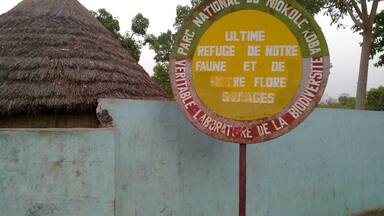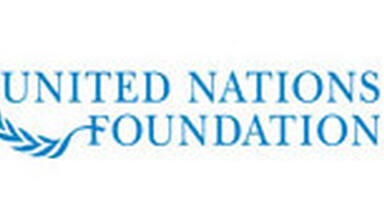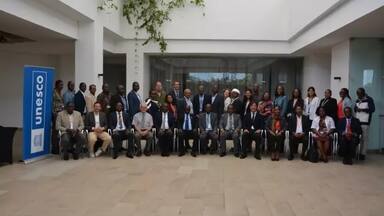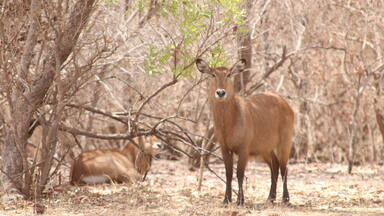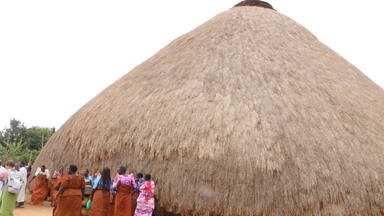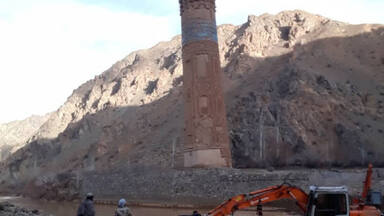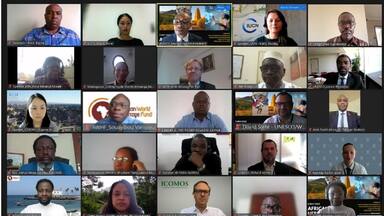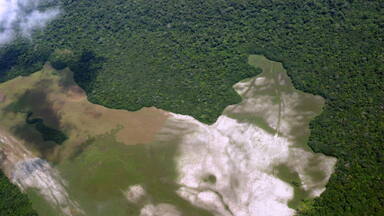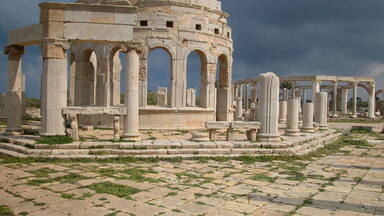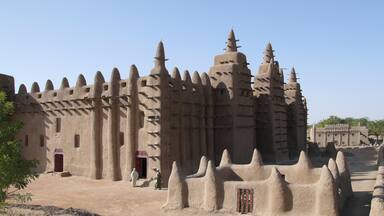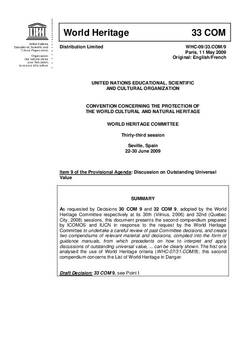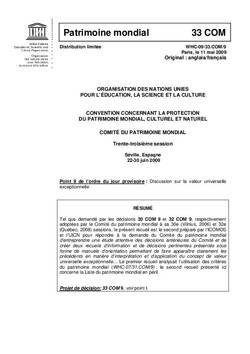World Heritage in Danger
The List of World Heritage in Danger is designed to inform the international community of conditions which threaten the very characteristics for which a property was inscribed on the World Heritage List, and to encourage corrective action. This section describes the List of World Heritage in Danger and gives examples of sites that are inscribed on the List.
Armed conflict and war, earthquakes and other natural disasters, pollution, poaching, uncontrolled urbanization and unchecked tourist development pose major problems to World Heritage sites. Dangers can be ‘ascertained’, referring to specific and proven imminent threats, or ‘potential’, when a property is faced with threats which could have negative effects on its World Heritage values.
At its 43rd session (Baku, 2019), the World Heritage Committee recalled that the inscription of a property on the List of World Heritage in Danger, aims to marshal international support to help the State Party effectively address the challenges faced by the property by engaging with the World Heritage Centre and the Advisory Bodies to develop a programme of corrective measures to achieve the Desired state of conservation for the property, as provided for under Paragraph 183 of the Operational Guidelines.
Implementing New Visions: A Guidebook for Action on the List of World Heritage in Danger
This Guidebook aims at providing practical strategies and examples based on the recommendations from the report "New Visions for the List of World Heritage in Danger” (see below) in order to change the way the story of the List of World Heritage in Danger is told and move away from negativity and focus on positive conservation efforts. It serves as a practical tool for all stakeholders of the World Heritage Convention, offering them guidance on how to overcome challenges and implement the recommendations. Let’s embark all together on this journey, recognizing the importance of preserving the cultural and natural heritage for the benefit of present and future generations.
Under the 1972 World Heritage Convention, a World Heritage property - as defined in Articles 1 and 2 of the Convention - can be inscribed on the List of World Heritage in Danger by the Committee when it finds that the condition of the property corresponds to at least one of the criteria in either of the two cases described below (paragraphs 179-180 of the Operational Guidelines):
For cultural properties
Ascertained Danger
The property is faced with specific and proven imminent danger, such as:
- serious deterioration of materials;
- serious deterioration of structure and/or ornamental features;
- serious deterioration of architectural or town-planning coherence;
- serious deterioration of urban or rural space, or the natural environment;
- significant loss of historical authenticity;
- important loss of cultural significance.
Potential Danger
The property is faced with threats which could have deleterious effects on its inherent characteristics. Such threats are, for example:
- modification of juridical status of the property diminishing the degree of its protection;
- lack of conservation policy;
- threatening effects of regional planning projects;
- threatening effects of town planning;
- outbreak or threat of armed conflict;
- threatening impacts of climatic, geological or other environmental factors.
For natural properties
Ascertained Danger
The property is faced with specific and proven imminent danger, such as:
- A serious decline in the population of the endangered species or the other species of Outstanding Universal Value for which the property was legally established to protect, either by natural factors such as disease or by human‑made factors such as poaching.
- Severe deterioration of the natural beauty or scientific value of the property, as by human settlement, construction of reservoirs which flood important parts of the property, industrial and agricultural development including use of pesticides and fertilizers, major public works, mining, pollution, logging, firewood collection, etc.
- Human encroachment on boundaries or in upstream areas which threaten the integrity of the property.
Potential Danger
The property is faced with major threats which could have deleterious effects on its inherent characteristics. Such threats are, for example:
- a modification of the legal protective status of the area;
- planned resettlement or development projects within the property or so situated that the impacts threaten the property;
- outbreak or threat of armed conflict;
- the management plan or management system is lacking or inadequate, or not fully implemented.
- threatening impacts of climatic, geological or other environmental factors.
Inscribing a site on the List of World Heritage in Danger allows the World Heritage Committee to allocate immediate assistance from the World Heritage Fund to the endangered property.
It also alerts the international community to these situations in the hope that it can join efforts to save these endangered sites. The listing of a site as World Heritage in Danger allows the conservation community to respond to specific preservation needs in an efficient manner. Indeed, the mere prospect of inscribing a site on this List often proves to be effective, and can incite rapid conservation action.
Inscription of a site on the List of World Heritage in Danger requires the World Heritage Committee to develop and adopt, in consultation with the State Party concerned, a programme for corrective measures, and subsequently to monitor the situation of the site. All efforts must be made to restore the site's values in order to enable its removal from the List of World Heritage in Danger as soon as possible.
Inscription on the List of World Heritage in Danger is not perceived in the same way by all parties concerned. Some countries apply for the inscription of a site to focus international attention on its problems and to obtain expert assistance in solving them. Others however, wish to avoid an inscription, which they perceive as a dishonour. The listing of a site as World Heritage in Danger should in any case not be considered as a sanction, but as a system established to respond to specific conservation needs in an efficient manner.
If a site loses the characteristics which determined its inscription on the World Heritage List, the World Heritage Committee may decide to delete the property from both the List of World Heritage in Danger and the World Heritage List. To date, this provision of the Operational Guidelines for the Implementation of the World Heritage Convention has been applied twice.
Illustrative cases
Some illustrative cases of sites inscribed on the List of World Heritage in Danger
Iranian city of Bam
The ancient Citadel and surrounding cultural landscape of the Iranian city of Bam, where 26,000 people lost their lives in the earthquake of December 2003, was simultaneously inscribed on UNESCO’s World Heritage List and on the List of World Heritage in Danger in 2004. Important international efforts are mobilized to salvage the cultural heritage of this devastated city.
Bamiyan Valley in Afghanistan
Bamiyan Valley in Afghanistan: This cultural landscape was inscribed on the List of World Heritage in Danger in 2003 simultaneously with its inscription on the World Heritage List. The property is in a fragile state of conservation considering that it has suffered from abandonment, military action and dynamite explosions. Parts of the site are inaccessible due to the presence of antipersonnel mines. UNESCO, at the request of the Afghan Government, coordinates all international efforts to safeguard and enhance Afghanistan’s cultural heritage, notably in Bamiyan.
Historic Town of Zabid in Yemen
The outstanding archaeological and historical heritage of the Historic Town of Zabid in Yemen has seriously deteriorated in recent years. Indeed, 40% of its original houses have been replaced by concrete buildings. In 2000, at the request of the State Party, the Historic Town of Zabid was inscribed on the List of World Heritage in Danger. UNESCO is helping the local authorities to develop an urban conservation plan and to adopt a strategic approach for the preservation of this World Heritage site.
Five World Heritage sites of the Democratic Republic of the Congo
The National Parks of Garamba, Kahuzi-Biega, Salonga, Virunga and the Okapi Wildlife Reserve in the Democratic Republic of the Congo: Since 1994, all five World Heritage sites of the DRC were inscribed on the List of World Heritage in Danger as a result of the impact of the war and civil conflicts in the Great Lakes region. In 1999, an international safeguarding campaign was launched by UNESCO together with a number of international conservation NGOs to protect the habitat of endangered species such as the mountain gorilla, the northern white rhino and the okapi. This resulted in a 4-year US$3.5 million emergency programme to save the five sites, funded by the United Nations Foundation and the Government of Belgium. In 2004, international donors, non-governmental organizations and the governments of Belgium and Japan pledged an additional US$50 million to help the Democratic Republic of the Congo rehabilitate these World Heritage parks.
How to help?
The States Parties to the Convention should inform the Committee as soon as possible about threats to their sites. On the other hand, private individuals, non-governmental organizations, or other groups may also draw the Committee's attention to existing threats. If the alert is justified and the problem serious enough, the Committee may consider including the site on the List of World Heritage in Danger.
To inform the World Heritage Committee about threats to sites, you may contact the Committee's Secretariat at:
World Heritage Centre
UNESCO
7, place de Fontenoy
75352 Paris 07 SP
France
Contact: World Heritage Centre


